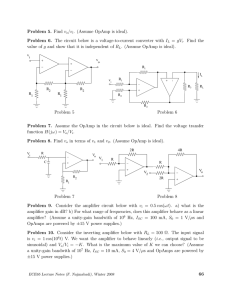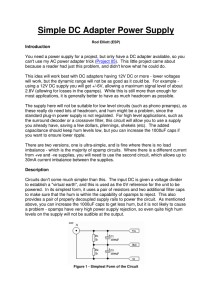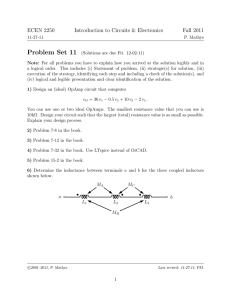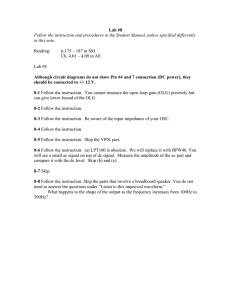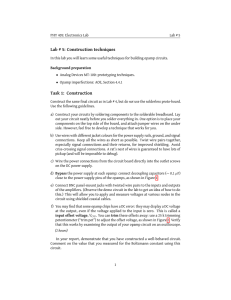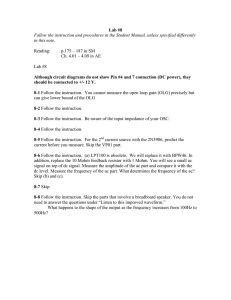Analog Integrated Circuits Exercise 1
advertisement
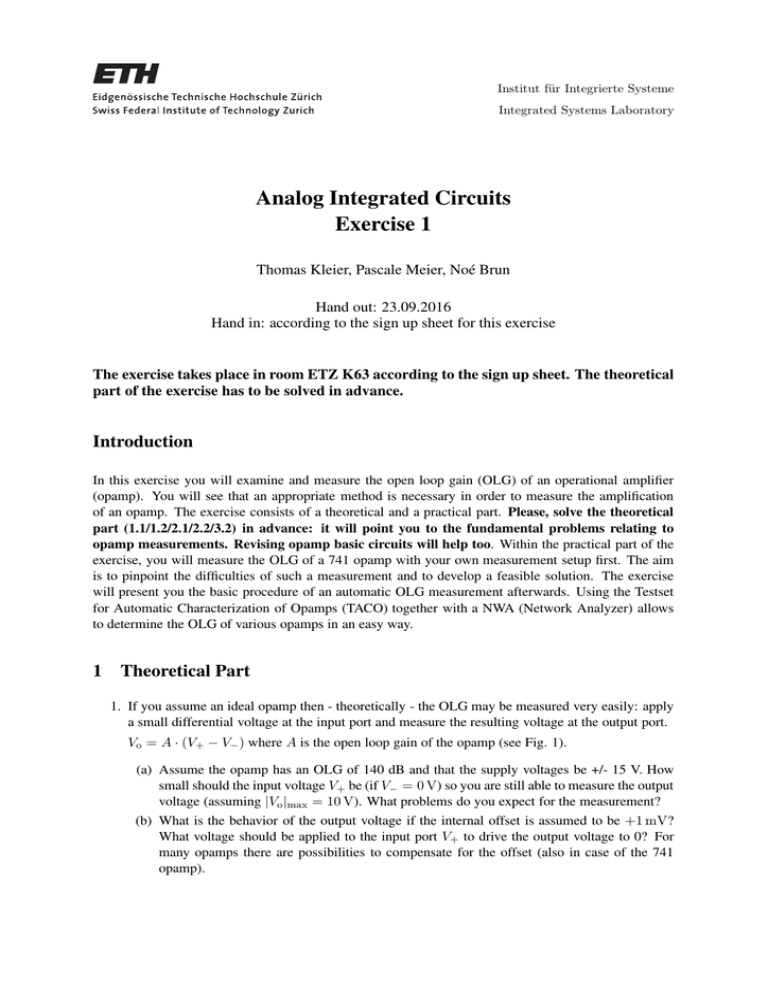
Institut für Integrierte Systeme Integrated Systems Laboratory Analog Integrated Circuits Exercise 1 Thomas Kleier, Pascale Meier, Noé Brun Hand out: 23.09.2016 Hand in: according to the sign up sheet for this exercise The exercise takes place in room ETZ K63 according to the sign up sheet. The theoretical part of the exercise has to be solved in advance. Introduction In this exercise you will examine and measure the open loop gain (OLG) of an operational amplifier (opamp). You will see that an appropriate method is necessary in order to measure the amplification of an opamp. The exercise consists of a theoretical and a practical part. Please, solve the theoretical part (1.1/1.2/2.1/2.2/3.2) in advance: it will point you to the fundamental problems relating to opamp measurements. Revising opamp basic circuits will help too. Within the practical part of the exercise, you will measure the OLG of a 741 opamp with your own measurement setup first. The aim is to pinpoint the difficulties of such a measurement and to develop a feasible solution. The exercise will present you the basic procedure of an automatic OLG measurement afterwards. Using the Testset for Automatic Characterization of Opamps (TACO) together with a NWA (Network Analyzer) allows to determine the OLG of various opamps in an easy way. 1 Theoretical Part 1. If you assume an ideal opamp then - theoretically - the OLG may be measured very easily: apply a small differential voltage at the input port and measure the resulting voltage at the output port. Vo = A · (V+ − V− ) where A is the open loop gain of the opamp (see Fig. 1). (a) Assume the opamp has an OLG of 140 dB and that the supply voltages be +/- 15 V. How small should the input voltage V+ be (if V− = 0 V) so you are still able to measure the output voltage (assuming |Vo |max = 10 V). What problems do you expect for the measurement? (b) What is the behavior of the output voltage if the internal offset is assumed to be +1 mV? What voltage should be applied to the input port V+ to drive the output voltage to 0? For many opamps there are possibilities to compensate for the offset (also in case of the 741 opamp). V+ A Vo V- Figure 1: Ideal open loop circuit. 2. As can be seen, measuring the OLG is not utterly straight-forward. The nonidealities of the opamp make measurements in open loop configuration (without feedback) impractical. The solution is to stabilize the opamp with a DC bias. Due to the DC bias, input and output voltages are fixed and can be measured more easily and with better accuracy. Unfortunately, even despite the feedback in the closed loop configuration, there are still some problems. (a) Input bias current: Have a look at Fig. 2. Rs and Rf are already determined. a1) Sketch the impact of the input current Ib on the transfer characteristic. a2) Determine the formula of Rb such that the input current Ib does not have any impact (hint: assume Vi = 0 V). Rb V+ Ib V- Vi A Vo Ib Rs Rf Figure 2: Typical closed loop circuit. (b) The measurement setup of Fig. 2 may be used to measure the OLG. How must the circuit be expanded so that you can determine A? Assume that you only have volt meters in the millivolt- to volt-range to your disposal. 2 Practical Part 1: Measurements at your own Setup 1. Fig. 3 shows a circuit that may be used to measure the DC OLG of an opamp. Consider its mode of operation: (a) Determine A = Vo Vn as a function of Vo Vi . (b) Add the necessary measurement instruments to the circuit of Fig. 3 2. Fig. 3 depicts the schematic of the circuit implemented on the ’AIC Ex1’ printed circuit board (PCB). Compare the PCB with its schematic. Ask an assistant to help if the you don’t understand any of the depicted symbols or if you see devices on the PCB you are not familiar with. A data sheet extract for the device under test (DUT), the wide-spread opamp 741 is found in the appendix. 2 Offset 1 +15V 3 J1 V- R2 -15V 1 V+ 2 * V20K GND 0V Offset 2 J3 R1 10K V+ R3 R4 2K 10K V+ 1 7 C1 10uF Offset 1 V+ U1 8 LM741 Vn 2 3 GND Vo DUT 6 GND 5 4 V- Offset 2 C2 10uF V- V- J4 GND R5 1K 4 VV+ GND 5 3 Vi 6 R6 GND 2 8 100 1 7 C3 10uF U2 OP27 GND GND V+ C4 10uF R7 J6 J7 100K V- Figure 3: Schematic of the simple OLG measurement setup of the ’AIC Ex1’ PCB. 3 3. Set the circuit in its initial configuration: • Do not connect your PCB to the power supply unit (PSU) – let an assistant check the setup prior to power-on! • Disconnect R2 • Disconnect the load resistor R5 Connect probes to measure the necessary voltages according to your solution of problem 1 with the volt meter and/or the oscilloscope. Which voltage do you expect at which point? • The circuit will consume roughly 20 mA from both, V + and V −. Choose a reasonable current limit and configure the PSU correctly. How do you connect it to the PCB? Show your solution to an assistant prior to connect the PCB to the supply. 4. Adjust R3 such that Vo = 0 V and measure the voltage Vi with the oscilloscope. (a) How large should the voltage Vi be in your opinion? Why does reality differ from your expectation? (b) The resistance R2 allows to drive Vi to 0. Have a look at the internal schematic of opamp 741 on its data sheet (appendix) and determine how R2 must be connected. (c) Change oscilloscope vertical coupling at Vi signal to AC and set Volt/Div to minimum. From the signal shown by the oscilloscope, it is hard to determine an average value. Why so? (d) This problem may be mitigated by an active low pass filter. Suppose there is a 50Hz ripple on the wanted DC signal. Realize an appropriate low pass filter to attenuate the ripple by 20dB. What value do you choose for the 3 dB frequency? 5. Draw the transfer characteristic Vi = f (Vo ) for R5 disconnected in the range −10 V ≤ Vo ≤ +10 V. How large is the load resistance seen by the output stage of the opamp 741? Determine the DC OLG A from the measurement and compare it to the data given in the data sheet. 6. Connect R5 = 1 kΩ to the DUT’s output terminal. How large is the load of the opamp 741 now? Repeat problem 5 for this new load. Does the curve match your expectations? If not, why so? 4 3 Practical Part 2: Measurements with the TACO and NWA 3.1 Configuration In order to determine the most important parameters of opamps (OLG, CMRR, PSRR, etc., refer to [1]), measurement instruments facilitating the measurement procedures have been developed. In this exercise you will use such a measurement instrument (the TACO) to measure the OLG of opamp 741 as a function of frequency. In addition to the TACO, you will use a network analyzer (NWA). Both instruments can be connected to a computer to make automatic measurements. Further details of the measurement setup are available from the TACO and NWA user manuals. Important: The input signal of the NWA is NOT to exceed 2 V! Otherwise, the NWA may get damaged! NWA DUT TACO R A Output RF OUT Reference Input Figure 4: Measurement setup. 3.2 Open Loop Gain Measurement The OLG is measured ’automatically’. From the amplitude and phase response, the following parameters may be determined: DC gain, unity gain frequency, phase margin and the dominant pole. Fig. 5 gives an overview of the TACO for an OLG measurement. S1 and S2 are used to switch between ’Calibration’ and ’Measurement’. 1. Consider the operating mode. What are the buffers B1 and B2 for? What is the amplifier A1 for? 2. Why must a calibration be done before the measurement? Fig. 6 shows the equivalent circuit for both switch positions. 3.3 Calibration of the OLG Measurement The equations result from the left schematic: A1 Vn = Vi B2 Vn = Vo Vo /Vi = B2 /A1 5 30dB A1 Vi 0dB R1 B1 R2 Vinp S2 0dB Vn R2’ S1 D.U.T. B2 Vod Vo Figure 5: Measurement setup to determine the OLG. Kalibration Messung A1 Vi A1 Vi B2 Vo R1 B1 R2 Vinp R2 Vn R2’ Vinp D.U.T. B2 Vod Vo Vn R2’ D.U.T. Vod Figure 6: Calibration and measurement. 3.4 Measurement of the OLG For the right schematic, the following equations apply: A1 Vn = Vi B2 Vod = Vo The OLG may now be determined to Vod /Vn = (A1 /B2 )(Vo /Vi ). 3.5 Opamp Measurement The OLG of opamp 741 shall be measured. The TACO instrument helps you to do so - but please, pay attention to the fact that the NWA only allows small voltages at its inputs. Therefore, check the voltages with the oscilloscope first. The NWA outputs a sinusoidal reference voltage that varies with frequency thereby realizing a frequency sweep. You can set the start and stop frequency as well as the signal 6 amplitude at the NWA. This signal is amplified by the opamp and the resulting signals Vi and Vo are fed back to the inputs of the NWA. The NWA stores the frequency response and determines the OLG. 1. Check whether the test setup has been connected correctly. 2. Set the parameters for the NWA as follows: (a) Press ’Format’, choose ’more’ and ’Log Mag + Phase’ (b) Press ’Meas’, choose ’A/R’ (c) Press ’Menu’, then ’Power’, and input ’-30 x1’ (d) Press ’Menu’, then ’Sweep Type Menu’, and choose ’Log Freq’, ’Freq Base’ (e) Press ’Avg’, choose ’IF BW’, and input ’2 x1’ (f) Press ’Scale Ref’, then ’Scale/div’, and input ’20 x1’ (g) Press ’Center’, and input ’5 MHz’ (h) Press ’Span’, then ’10 MHz’ (i) Press ’Atten’, choose ’A’, and input ’0 dB’ 3. First, have a look at the output signal of the NWA with the oscilloscope. Check that the signal after amplification by the opamp is still small enough not to cause any damage to the NWA. 4. Plug a 741 opamp in the green test socket of the TACO and switch the instrument on. The ’Calib’ LED is burning. Press ’Update’. 5. Calibrate the test setup in the OLG mode. (a) Press ’Menu’, then ’Measure Restart’, and only have a look at the data (’Display’, ’Define Trace’, ’Data’). (b) Let the cursor complete a full cycle and store the data to the memory (’Display’, ’Define Trace’, ’Data → Mem’) (c) To have the NWA calculate the OLG directly, press ’Display’, ’Define Trace’, ’Data/Memory’. 6. Measure the OLG. (a) Press ’Calib’ at the TACO and then ’Update’. The OLG is measured now. 7. Plot the amplification and the phase up to 10 MHz. Read out the characteristic parameters of the opamp listed below and fill in the table in section 4. (a) DC gain (b) Gain-bandwidth (GBW) (c) Phase margin (d) Dominant pole 7 4 Summary Op (load) 741 DC gain GBW Measurement results Ph. margin Stable? 8 1st pole Application example References [1] TACO User Manual. Katholieke Universiteit Leuven, Dept. Elektrotechniek. [2] How to Test Basic Operational Amplifier Parameters. Analog Devices, Application Note. [3] How to Select Operational Amplifiers. Analog Devices, Application Note. [4] J. R. Riskin: A User’s Guide to IC Instrumentation Amplifiers. Analog Devices, Application Note. [5] P. Brokaw: An I.C. Amplifier Users’ Guide to Decoupling, Grounding and Making Things Go Right for a Change. Analog Devices, Application Note. [6] W.Sansen, M.Steyaert, P.Vandeloo: Measurement of operational amplifier characteristics in the frequency domain. IEEE Transactions on instrumentation and measurements, Vol. 1M-34, No. 1, March 1985. [7] P.E.Allen, D.R.Holberg: CMOS Analog Circuit Design. Holt,Rinehart and Winston, New York, 1987. [8] P.Gray, R. Meyer: Analysis and Design of Analog Integrated Circuits. John Wiley and Sons, Inc., New York, 1993. [9] J.K.Roberge: Operational Amplifiers: Theory and Practice. John Wiley and Sons, Inc., New York, 1975. [10] S.D.Senturia, B.D.Wedlock: Electronic Circuits and Applications. John Wiley and Sons, Inc., New York, 1975. [11] H. Benedickter: Praktikumsanleitung Netzwerkanalysator. Institut für Feldtheorie und Höchstfrequenztechnik, 1990. 9 Appendix Many opamps are compatible in their pin assignment. This is also true for the opamps (LM741, OP27) used in this exercise. Their pin assignment is given in Fig. 7. + 3 + Offset Pin 1 8 N.C. Inverting Input 2 7 V+ Non-inverting Input 3 6 Output 4 5 Offset Pin 7 6 2 _ 4 V- _ Figure 7: Pin assignments of many opamps. For the wide-spread standard opamp 741 the internal schematic is reproduced here. Further details both for the opamp 741 and for the other opamps can be found in the data sheets provided during the exercise. Figure 8: Internal schematic. 10 Glossary The GAIN-BANDWIDTH PRODUCT for an operational amplifier is computed by multiplying gain and bandwidth (in Hertz) of a point on the falling slope of the first order amplifier amplitude characteristic. For any given operational amplifier, the gain-bandwidth product will remain the same regardless of the amount of feedback used. Phase margin is defined as follows: Phase margin = 180◦ + phase(@LG=1). For stability, PM has to be greater than 0◦ . 4 10 3 10 2 GAIN 10 Loop Gain = 1 1 10 0 10 −1 10 −2 10 −1 10 0 10 1 10 2 10 3 10 4 5 10 10 6 10 PHASE 0 −90 Phase margin −180 −1 10 0 10 1 10 2 10 3 10 4 10 Figure 9: Gain and phase versus frequency for a single-pole amplifier. 11 5 10 6 10
